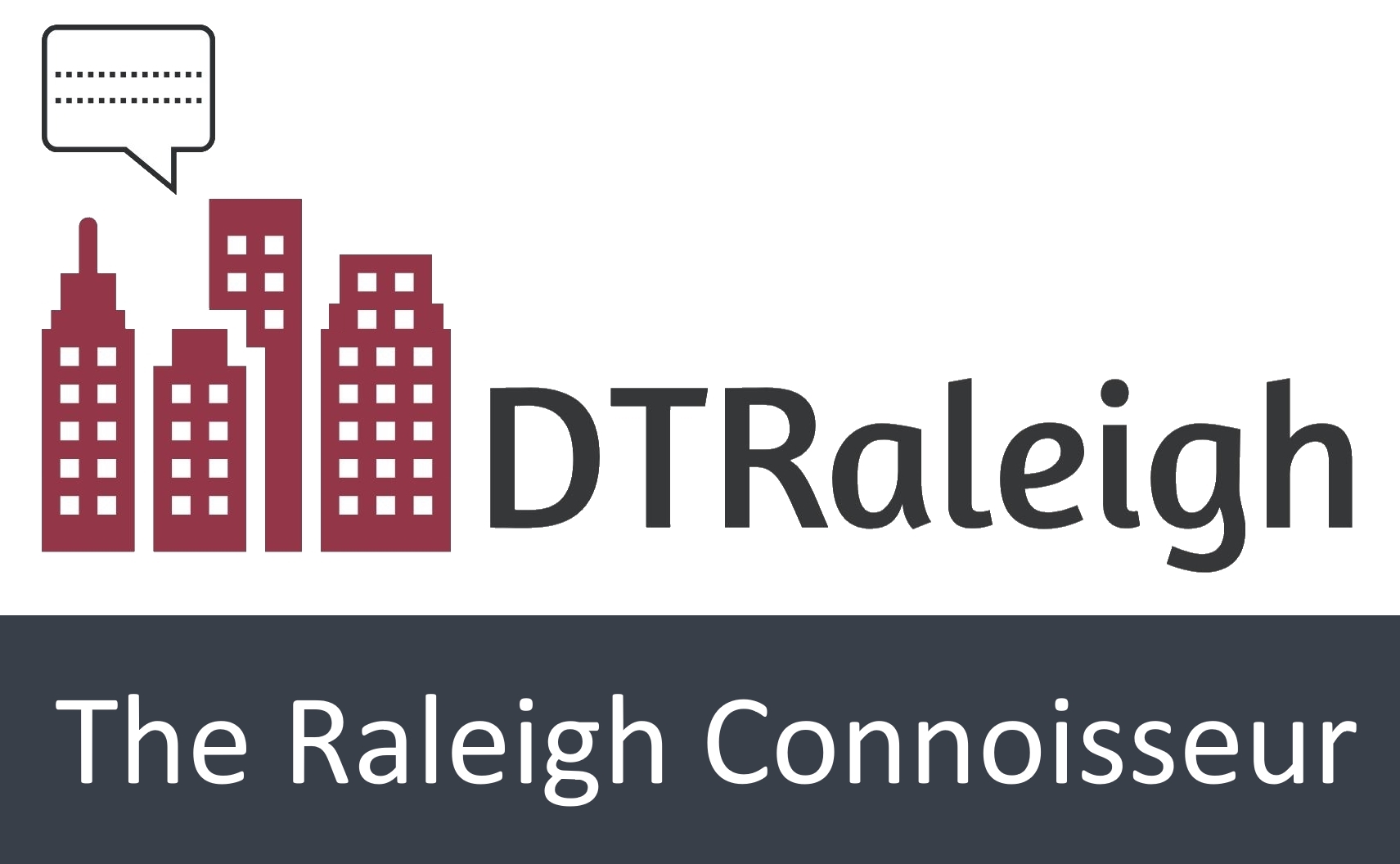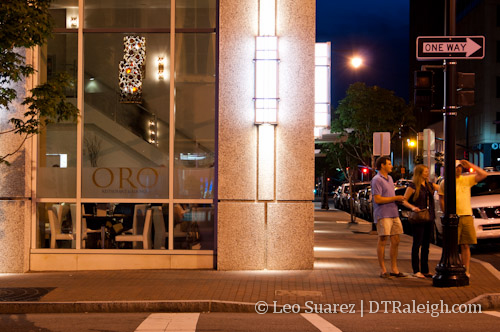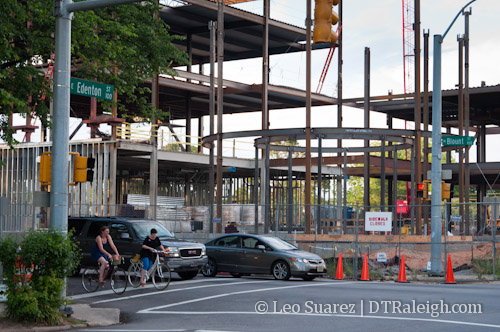Oak City Cycling is promoting cycling as a viable commuting alternative. Here’s a great video of what these guys are up to in and around downtown Raleigh.
CityCamp Raleigh Sets Up For Year 2 This Weekend, $5000 Prize
Last year, CityCamp Raleigh raised the bar on the city’s adoption of open-sourced solutions and helped bring citizens to the problem solving table. This weekend, the gang behind the event are hosting it again with the same $5000 prize for the best idea and solution.
Within a year, CityCamp has been at the root of a few accomplishments in the city as the website states:
Here are some of the ways the first CityCamp Raleigh was an inspiration or catalyst in helping to advance open government and create next-generation solutions locally:
- The Raleigh City Council unanimously approved a resolution stating its intent to foster “open” government by encouraging the use of open-source systems and open access to data.
- City Councilors agreed to provide $50,000 annually to fund an open data catalog. Raleigh city data will be digitally published and made ready for use by city residents, software developers or news outlets.
- City of Raleigh website visitors can now sign up for a free service called MyRaleigh Subscriptions that delivers email and text alerts about topics such as street closings, public meetings, city projects, and events.
- Help spur the TriangleWiki project – a free, openly-editable, community-owned website that gathers first-hand information on local history, events, greenways, parks and everything interesting related to the Triangle region.
CityCamp now sets up Raleigh for even more throughout the next year and everyone is invited to the free event this weekend.
Register for all or just parts of the CityCamp weekend.
Friday, June 1
Where: Vintage 21 (117 S. West Street)
Time: Doors at 12pm, Panel discussion and lightning talk at 1pm.
Saturday/Sunday June 2 and 3
Where: AIA NC (14 E. Peace Street)
Time: Saturday 9-5, Sunday 10-3 with group presentations to follow.
See and hear more about CityCamp.
- CityCamp Raleigh Flickr Group
- CityCamp Raleigh Youtube channel
Spring 2012 Restaurant Roundup
Summer isn’t quite here yet so keep enjoying the fabulous weather we’re having before the heat arrives. While you’re out exploring, a few new eats are in the works as well as some upcoming ones that continue to test our patience. Ever since the winter update, there hasn’t been as much movement on the eats list as some of the past seasons.
You can still find new places to eat on the ever growing Eats list though. Here’s the latest tips and openings to look forward to:
- Oro has opened this past weekend and the tapas menu looks very tempting. They are located in the PNC Plaza building at the corner of Martin and Wilmington Street. (photo above)
- With the Nature Research Center opening in April, the Daily Planet Cafe on Jones Street is open with the museum’s hours. It may not be for a night out but with local ingredients and beer, it could make for a solid lunch.
- Blue Mango in Glenwood South has opened in the 222 building.
- The Raleigh Times is expanding, adding more seats and a rooftop area.
- A Laotian restaurant, Bida Manda, is planned to open at the former location of Fai Thai on Blount Street.
- Zinda, the Pan-Asian restaurant coming to the PNC building, is still covered up and waiting to open. According to their Twitter, they are now hiring:
https://twitter.com/#!/ZindaRaleigh/status/202048507710935040
Pic of the Week
The North Carolina State Bar building under construction at the corner of Blount and Edenton Streets. We’ve discussed the building before. (with a rendering)
The City of Raleigh Flag

About a week ago, Josh Shaffer at the N&O wrote a piece about what could be the new icon for Raleigh. He suggests that the now open Nature Research Center’s 70-foot globe needs consideration for that title. The bronze acorn and the shimmer wall were other landmarks mentioned but I’m going to throw the City of Raleigh flag into the mix. Yes, Raleigh has a flag and in case you haven’t seen it this post will take care of that. The flag should always be considered one of our core symbols and I don’t think we give it enough love.
In other cities, the flag is a sense of pride. Chicago and Washington DC have great flags and if you’re lucky, you may find citizens with tattoos of it. (anyone in Raleigh can claim having this?)
In 2004, the North American Vexillological Association did a survey against 150 US city flags. Respondents answered on a 0 to 10 scale on what they thought were a well designed flags. We ranked 56 on that list, highest North Carolina city by the way, so flag design may not be a huge feather in our cap.
Still, I want to ask this question; Why are there so few Raleigh flags around town?
The Raleigh flag design is over 100 years old but has an interesting history that may explain it’s rather nonexistent role in our city.
A Little History
The City of Raleigh flag has a nice, mysterious story to it as its original purpose was not made for the city at all. The most influential event on this would be during the Battle of Manila Bay on May 1, 1898 as part of the Spanish-American War.
The USS Raleigh (second US ship named after the city at the time) played a key role in the fighting in the Philippines and back at home, the local newspapers kept Raleighites enthralled with stories of victory at Manila Bay. Thomas R. Jernigan, a former Raleigh resident who was representing the United States in China at the time wrote home saying:
tell Mayor [William M.] Russ she was in the thickest of the fight and came out in excellent shape. The Raleigh is a splendid vessel, and may be counted on to do her share of the fighting in this war.”
The cruiser would stay in Asia for a bit longer returning back to the United States with a stop in New York in April of 1899. The city sent representatives there for the national welcoming reception for the ship.
At the same time that month, the Raleigh Board of Aldermen (what is now a version of our current city council) decided to give a city flag as a gift to the cruiser. A flag had not existed at the time and so began the process in creating one. A special committee was formed for this specific purpose.
First, color was needed. The colors of red and yellow were adopted for the city’s centennial (1892) however for the flag, these two colors were seen as “too Spanish” and not used. Sir Walter Raleigh’s colors of red and white were chosen instead and described as “the colors emblematic of Raleigh.”
The Board of Aldermen then contracted Miss Kate Denson to design the flag for a fee of $50. Her flag consisted of three colored, vertical stripes (red, white, red) with unique designs on each side. On one side, the flag contained a figure of an oak tree inside a gold circle with the words “City of Raleigh, North Carolina, 1792” all surrounded by a wreath of oak leaves and acorns. The other side contains the Sir Walter Raleigh coat of arms with the words, “Presented to the U.S. Cruiser Raleigh, the ‘First and Last at Manila.'”
While Miss Denson was contracted in April 1899, other events with the ship were ongoing.
News that the ship would next make a stop in Wilmington, North Carolina quickly spread and Raleigh made big plans for a welcome party in the port city. In addition, there was news that the ship’s officers and crew were going to present “a gun captured at Manila” as a gift to the city. The “Nordenfeldt 3-pounder” was given to the city on May 5, 1899 and then again the day after at a more formal ceremony.
Miss Denson’s flag was not ready in time and Attorney R. N. Simms, spokesman for the city, made an announcement at the ceremony that “a handsome flag of the new city colors” would be later delivered.
It’s not proven whether the flag ever made it to the ship because the USS Raleigh was decommissioned in June and Miss Denson would complete the flag in October. That month, the 43″ x 69″ flag with gilded fringes all around flew at the North Carolina State Fair. The flag was officially presented to the Board of Alderman on December 1, 1899. Satisfied with her work, they contracted with her for a second flag for the City of Raleigh. No records exist whether this flag still had the Manila Bay reference like the original did.
Here’s where the mystery starts to settle in.
The USS Raleigh was recommissioned during the periods of 1903-1907 and 1911-1919. No records exist proving the flag ever flew on the ship.
In 1938, one of these two flags was lent to the next USS Raleigh (third US ship named after Raleigh) in order to be copied. Upon return, then City Clerk J. E. Sawyer noted that it was “now nearly worn out.” This left Raleigh with one remaining flag.
The mystery is now in full effect as no mention or public record of the flag has been found after 1938.
In 1960, the flag resurfaced. William Carper, the City Manager at the time, found one of the flags in a storage area within City Hall. Talks of making the flag official for the city started and during that same year the city council adopted the design as the “authentic flag of the city.”
Restoring the uncovered flag was an eleven year process and it returned to Raleigh in 1980 where it was on display at City Hall.
On the flag’s 100th birthday, 1999, the flag was given to the Raleigh City Museum.
Back to the present
Today, the flag found in 1960 is still on display at the city museum with a recently updated exhibit. Along with much more information than provided here, the exhibit has a nice artist rendering of the second USS Raleigh.
So how does one get a copy of our city flag?
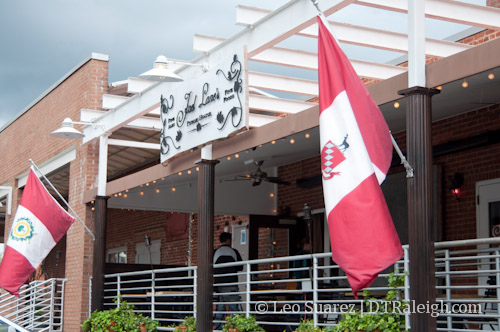
City of Raleigh flags outside of Joel Lane’s Public House
My research has fallen rather flat as the flag is a custom design and is pretty costly for someone to get through a flag shop. Where’s the local vexillographer at anyway?
The city does have a stash of custom made flags for sale in case someone is interested. For $98, you can get a 4′ x 6′ flag to show your pride. Talk to Barbara at the city Public Affairs office (919-996-3001) to make arrangements.
Who will be the first to step up and make the Raleigh flag available for the masses? If anyone is interested in city branding, this could be a topic to expand on.
Raleigh Musings, A New Banner, and Life
Another week, another disappointment. Am I disappointed with downtown Raleigh? Absolutely not. I hope everyone has had the opportunity to just be outside and to walk around these days. The trees are practically full now and the warm breezes are refreshing. Even with that going on, I’m disappointed with the amount of blogging I’ve done here on RalCon and I bet long time readers have noticed the slow down. I’m using this blog post to reflect a bit.
I’ve updated the banner image on the site and I’m a bit excited about it. For awhile I’ve had a version of this great skyline shot I took from down in the Boylan Wye. It has been almost three years since I took that photo and used it as the site’s banner image. Slowly, very slowly, I’ve started to realize that the skyline shouldn’t be what Raleigh is about at all.
Downtown Raleigh’s real life is on the sidewalks and the growth that this blog has been following for the past five years is all about the network of treasures within this small area. It’s not what you see from afar but what is happening between those buildings that make downtown Raleigh a place to be and experience. I’ve found myself becoming more and more interested in the human interactions that occur around all those structures within the five districts of downtown.
The banner image is a snapshot of humans interacting on what is clearly our main street, Fayetteville Street. This is how I want to showcase our city. I hope an image like this and ones similar to it make any new visitor to this blog see it and think, “Hey, I want to be there.”
Transit, public space, the sidewalks and the businesses that connect are just some of the topics I want to keep talking about. New buildings are a part of it and while the skyline looks great on TV in high-def it is not what is going to keep people coming back if there’s no life in downtown. I’ve realized that I’ve been taking this approach ever since day one of blogging for RalCon. All my material and photos come from walking the sidewalks and seeing things for myself.
My job is more demanding these days and life put me as the star (or the number 2 as most people tell me) of an upcoming wedding so times are tight. Along with some neighborhood projects to keep me busy I’m sometimes slammed and I can’t get to these great topics mentioned earlier.
But times may change and we’ll one day get to discuss those topics more in-depth. Get out and walk downtown Raleigh tonight or this weekend. It’s a great time to do it.
Bad Outdoor Seating or Bad Location?
Now that we’re into the spring season, outdoor seating during the warmer hours is in high demand. Downtown Raleigh actually has a plentiful amount of outdoor seating options with some doing it better than others. That’s for another post but here I wanted to highlight an interesting seating situation.
Take a look at the photo above. (click for larger) It shows the outdoor seating balcony of the Wilmoore Cafe located on Wilmington Street. The seating is slightly overlooking the walkway that connects the Moore Square bus station to Wilmington Street in the middle of the block. From what I hear and the times I’ve been by, very little, if any, people are actually using this outdoor seating.
So I’ll back up and admit that when the Wilmoore Cafe first opened, I thought that this balcony here would be great outdoor seating. I still do and in fact, there is a lot of potential for all that space behind the buildings of Wilmington Street and under the Moore Square parking deck. So when I heard that a lot of people don’t end up sitting out here I started to wonder.
The photo I have posted here is not during work hours so bear with me.
The balcony at first glance seems to have everything that a great outdoor seating space should have. It’s small and cozy. There’s a bit of separation between yourself and the walkway but not too much that you feel detached. The tree cover adds a hint of nature to the setting. The area is also not empty during work hours as people walk through here all the time so there’s plenty of people watching opportunities. People attract more people to any public space.
There’s something about this part of the station that I really enjoy. I walk through it all the time. The more complex nature of steps and walkways that are completely away from the street makes it feel urban. It’s a very different place within our city. So could this be a part of the reason that this great balcony for morning coffee drinkers isn’t working?
Outdoor seating within the core of downtown is dominated by sidewalk seating. The Raleigh Times, Capital Club 16, The Big Easy, Vic’s, Tir Na Nog, and many more restaurants just place the tables and chairs on the sidewalks and people flock. What is it about the sidewalk that works so well?
To me, I think sitting on the sidewalk puts you right in the middle of the traffic, the sidewalk traffic that is. The people watching when sitting on the sidewalk is so much more enjoyable than being inside. I also think that we’re all just in love with what is going on up and down the streets. The vehicle traffic provides that background noise that makes things more comfortable. Ever been to a party with the music turned off?
So back to the Wilmoore Cafe balcony and the photo at the beginning of this post. Could people not be sitting here because it’s simply not the sidewalk? Maybe it’s too far from the street? Or perhaps nobody knows about it?
The area has some flaws however and they are shown in the photo. You can see several cars parked right underneath the parking deck and pedestrians have to weave through them. There used to be a fountain here. Does anyone know what happened to it, why it was removed? The lighting is also that ugly amber that makes you feel like you are under a highway. I think it’s these little things that could make a big difference if re-thought.
Like I said, I think there is a lot of potential for a great public space inside this block that has the Moore Square bus station. However, it needs a people friendly touch so that visitors stop and visit rather than pass through. Some of these things, I hope to see as part of the Moore Square bus station upgrade that is upcoming in the next few years. That may create more cozy balconies and alcoves for us humans to stop and relax in.
Introducing Link Peace Street, A Resident Backed Alternative For Capital Boulevard and Peace Street
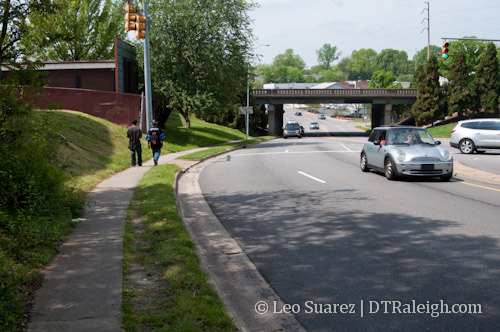
There’s a new project that’s growing some legs in downtown Raleigh. Link Peace Street is a vision from Raleigh residents for a more walkable environment on Peace Street. It coincides with the Capital Boulevard Corridor Study and hopes to put another alternative onto the table that is currently not being considered. I’m helping out with the effort and the core focus of it revolves around creating a plan for an at-grade intersection at Capital Boulevard and Peace Street.
Over the next few days, more information will be put onto the vision website of Link Peace Street so I encourage readers to check out the site we’ve built and sign up for updates.
Link Peace Street revolves around three main goals,
- Economic development in a form that fits into downtown Raleigh.
- Strengthen the connections between neighborhoods.
- Deliver on the 2030 Comprehensive Plan.
The Capital Boulevard Corridor Study, taking public comments at this time, targets private investment in the area using several projects. Some of those include an expanded greenway, a park at the old Devereux Meadow site, and multiple tweaks to Capital Boulevard itself. We’ve mentioned here before that the state of North Carolina is going to replace the bridge over Peace Street within a few years. The study wants to piggyback on that project and is considering some alternative routes to getting on and off of Peace Street. You can read about those alternatives on the Peace Street Vision document in the sidebar on the city’s website. These ideas are what planners think will help spur private investment in the area.
All plans being considered so far include the new NCDOT designed bridge and Link Peace Street wants them to consider the ‘no bridge’ option. We feel that the upgrades to Capital Boulevard, outlined in the study document, only promote more speed and will continue keeping vehicles moving through the area rather than stopping at a destination. Peace Street is the northern border of downtown Raleigh but most people don’t see it that way as the built landscape is not meant for a downtown at all. It’s possible that an environment that balances pedestrians, cyclists, and vehicles can promote development that is appropriate for downtown Raleigh and is a much better use of land.
With vehicles speeds kept the same and not increased, a walkable Peace Street will connect the neighborhoods rather than be an obstacle between them. In March, the Blount Street Commons project was asking the Raleigh City Council for a zoning change to allow for more density. At the same time, there is an apartment boom near Glenwood South. Both neighborhoods are so close yet feel much farther because of the uneasy walk down Peace Street in its current state.
It is a half mile walk from the Mellow Mushroom to Tyler’s Taproom yet so few people make that walk. In comparison, Fayetteville Street from one end to the other is a half mile. Peace Street may never have the towers and historic structures of Fayetteville Street but we think that we can atleast set up Peace Street for the same walkable experience. To have it, it starts with people and not vehicles.
The 2030 comprehensive plan specifies that this area is in the Core Business District category. It states:
This category applies to the Raleigh Central Business District, and is intended to enhance Downtown Raleigh as a vibrant mixed use urban center. The category recognizes the area’s role as the heart of the city, supporting a mix of high-intensity office, retail, housing, government, institutional, visitor-serving, cultural, and entertainment uses. Multiple zoning districts apply within the CBD, corresponding to the different character and vision for its various neighborhoods. The maximum residential density in this area would be 320 units per acre with densities tapering off towards edge areas adjacent to established residential neighborhoods, but not falling below 40 units per acre.
The Capital Boulevard study wants to widen lanes and help the flow of traffic. This does not fit with the description above and Link Peace Street feels that goes against the plan adopted just a few years ago.
How can we continue to do what we’ve been doing here in the corridor and expect different results?
Insanity: doing the same thing over and over again and expecting different results.
-Albert Einstein
We’re hoping to build support for the idea before the study is brought to the city council before the May 1st meeting.
